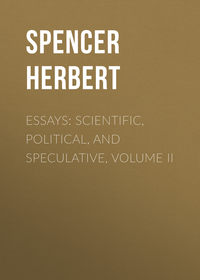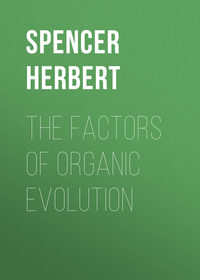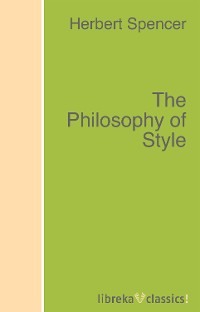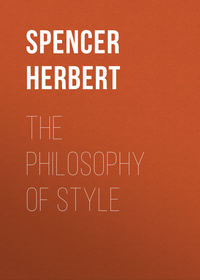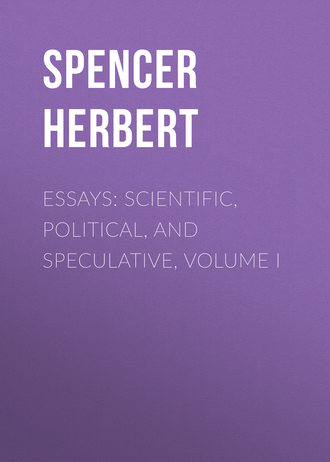 полная версия
полная версияEssays: Scientific, Political, and Speculative, Volume I
Now it seems to us that the various kinds of integration here exemplified, which are commonly set down as so many independent phenomena, ought to be generalized, and included in the formula describing the process of development. The fact that in an adult crab, many pairs of ganglia originally separate have become fused into a single mass, is a fact only second in significance to the differentiation of its alimentary canal into stomach and intestine. That in the higher Annulosa, a single heart replaces the string of rudimentary hearts constituting the dorsal blood-vessel in the lower Annulosa, (reaching in one species to the number of one hundred and sixty), is a truth as much needing to be comprised in the history of evolution, as is the formation of a respiratory surface by a branched expansion of the skin. A right conception of the genesis of a vertebral column, includes not only the differentiations from which result the chorda dorsalis and the vertebral segments imbedded in it; but quite as much it includes the coalescence of numerous vertebral processes with their respective vertebral bodies. The changes in virtue of which several things become one, demand recognition equally with those in virtue of which one thing becomes several. Evidently, then, the current statement which ascribes the developmental progress to differentiations alone, is incomplete. Adequately to express the facts, we must say that the transition from the homogeneous to the heterogeneous is carried on by differentiations and accompanying integrations.
It may not be amiss here to ask – What is the meaning of these integrations? The evidence seems to show that they are in some way dependent on community of function. The eight segments which coalesce to make the head of a centipede, jointly protect the cephalic ganglion, and afford a solid fulcrum for the jaws, &c. The many bones which unite to form a vertebral skull have like uses. In the consolidation of the several pieces which constitute a mammalian pelvis, and in the anchylosis of from ten to nineteen vertebræ in the sacrum of a bird, we have kindred instances of the integration of parts which transfer the weight of the body to the legs. The more or less extensive fusion of the tibia with the fibula and the radius with the ulna in the ungulated mammals, whose habits require only partial rotations of the limbs, is a fact of like meaning. And all the instances lately given – the concentration of ganglia, the replacement of many pulsating blood-sacs by fewer and finally by one, the fusion of two uteri into a single uterus – have the same implication. Whether, as in some cases, the integration is merely a consequence of the growth which eventually brings into contact adjacent parts performing similar duties; or whether, as in other cases, there is an actual approximation of these parts before their union; or whether, as in yet other cases, the integration is of that indirect kind which arises when, out of a number of like organs, one, or a group, discharges an ever-increasing share of the common function, and so grows while the rest dwindle and disappear; – the general fact remains the same, that there is a tendency to the unification of parts having similar duties.
The tendency, however, acts under limiting conditions; and recognition of them will explain some apparent exceptions. In the human fœtus, as in the lower vertebrata, the eyes are placed one on each side of the head. During evolution they become relatively nearer, and at birth are in front; though they are still, in the European infant as in the adult Mongol, proportionately further apart than they afterwards become. But this approximation shows no signs of further increase. Two reasons suggest themselves. One is that the two eyes have not quite the same function, since they are directed to slightly-different aspects of each object looked at; and, since the resulting binocular vision has an advantage over monocular vision, there results a check upon further approach towards identity of function and unity of structure. The other reason is that the interposed structures do not admit of any nearer approach. For the orbits of the eyes to be brought closer together, would imply a decrease in the olfactory chambers; and as these are probably not larger than is demanded by their present functional activity, no decrease can take place. Again, if we trace up the external organs of smell through fishes,7 reptiles, ungulate mammals and unguiculate mammals, to man, we perceive a general tendency to coalescence in the median line; and on comparing the savage with the civilized, or the infant with the adult, we see this approach of the nostrils carried furthest in the most perfect of the species. But since the septum which divides them has the function both of an evaporating surface for the lachrymal secretion, and of a ramifying surface for a nerve ancillary to that of smell, it does not disappear entirely: the integration remains incomplete. These and other like instances do not however militate against the hypothesis. They merely show that the tendency is sometimes antagonized by other tendencies. Bearing in mind which qualification, we may say, that as differentiation of parts is connected with difference of function, so there appears to be a connexion between integration of parts and sameness of function.
Closely related to the general truth that the evolution of all organisms is carried on by combined differentiations and integrations, is another general truth, which physiologists appear not to have recognized. When we look at the organic world as a whole, we may observe that, on passing from lower to higher forms, we pass to forms which are not only characterized by a greater differentiation of parts, but are at the same time more completely differentiated from the surrounding medium. This truth may be contemplated under various aspects.
In the first place it is illustrated in structure. The advance from the homogeneous to the heterogeneous itself involves an increasing distinction from the inorganic world. In the lowest Protozoa, as some of the Rhizopods, we have a homogeneity approaching to that of air, water, or earth; and the ascent to organisms of greater and greater complexity of structure, is an ascent to organisms which are in that respect more strongly contrasted with the relatively structureless masses in the environment.
In form again we see the same truth. A general characteristic of inorganic matter is its indefiniteness of form, and this is also a characteristic of the lower organisms, as compared with the higher. Speaking generally, plants are less definite than animals, both in shape and size – admit of greater modifications from variations of position and nutrition. Among animals, the Amœba and its allies are not only almost structureless, but are amorphous; and the irregular form is constantly changing. Of the organisms resulting from the aggregation of amœba-like creatures, we find that while some assume a certain definiteness of form, in their compound shells at least, others, as the Sponges, are irregular. In the Zoophytes and in the Polyzoa, we see compound organisms, most of which have modes of growth not more determinate than those of plants. But among the higher animals, we find not only that the mature shape of each species is quite definite, but that the individuals of each species differ very little in size.
A parallel increase of contrast is seen in chemical composition. With but few exceptions, and those only partial ones, the lowest animal and vegetal forms are inhabitants of the water; and water is almost their sole constituent. Dessicated Protophyta and Protozoa shrink into mere dust; and among the acalephes we find but a few grains of solid matter to a pound of water. The higher aquatic plants, in common with the higher aquatic animals, possessing as they do much greater tenacity of substance, also contain a greater proportion of the organic elements; and so are chemically more unlike their medium. And when we pass to the superior classes of organisms – land plants and land animals – we find that, chemically considered, they have little in common either with the earth on which they stand or the air which surrounds them.
In specific gravity, too, we may note the like. The very simplest forms, in common with the spores and gemmules of the higher ones, are as nearly as may be of the same specific gravity as the water in which they float; and though it cannot be said that among aquatic creatures superior specific gravity is a standard of general superiority, yet we may fairly say that the superior orders of them, when divested of the appliances by which their specific gravity is regulated, differ more from water in their relative weights than do the lower. In terrestrial organisms, the contrast becomes extremely marked. Trees and plants, in common with insects, reptiles, mammals, birds, are all of a specific gravity considerably less than the earth and immensely greater than the air.
We see the law similarly fulfilled in respect of temperature. Plants generate but an extremely small quantity of heat, which is to be detected only by delicate experiments; and practically they may be considered as being in this respect like their environment. Aquatic animals rise very little above the surrounding water in temperature: that of the invertebrata being mostly less than a degree above it, and that of fishes not exceeding it by more than two or three degrees, save in the case of some large red-blooded fishes, as the tunny, which exceed it by nearly ten degrees. Among insects, the range is from two to ten degrees above that of the air: the excess varying according to their activity. The heat of reptiles is from four to fifteen degrees more than that of their medium. While mammals and birds maintain a heat which continues almost unaffected by external variations, and is often greater than that of the air by seventy, eighty, ninety, and even a hundred degrees.
Once more, in greater self-mobility a progressive differentiation is traceable. Dead matter is inert: some form of independent motion is our most general test of life. Passing over the indefinite border-land between the animal and vegetable kingdoms, we may roughly class plants as organisms which, while they exhibit the kind of motion implied in growth, are not only without locomotive power, but in nearly all cases are without the power of moving their parts in relation to one another; and thus are less differentiated from the inorganic world than animals. Though in those microscopic Protophyta and Protozoa inhabiting the water – the spores of algæ, the gemmules of sponges, and the infusoria generally – we see locomotion produced by ciliary action; yet this locomotion, while rapid relatively to their sizes, is absolutely slow. Of the Cœlenterata, a great part are either permanently rooted or habitually stationary, and so have scarcely any self-mobility but that implied in the relative movements of parts; while the rest, of which the common jelly-fish serves as a sample, have mostly but little ability to move themselves through the water. Among the higher aquatic Invertebrata, – cuttle-fishes and lobsters, for instance, – there is a very considerable power of locomotion; and the aquatic Vertebrata are, considered as a class, much more active in their movements than the other inhabitants of the water. But it is only when we come to air-breathing creatures that we find the vital characteristic of self-mobility manifested in the highest degree. Flying insects, mammals, birds, travel with velocities far exceeding those attained by any of the lower classes of animals; and so are more strongly contrasted with their inert environments.
Thus, on contemplating the various grades of organisms in their ascending order, we find them more and more distinguished from their inanimate media in structure, in form, in chemical composition, in specific gravity, in temperature, in self-mobility. It is true that this generalization does not hold with regularity. Organisms which are in some respects the most strongly contrasted with the inorganic world, are in other respects less contrasted than inferior organisms. As a class, mammals are higher than birds; and yet they are of lower temperature, and have smaller powers of locomotion. The stationary oyster is of higher organization than the free-swimming medusa; and the cold-blooded and less heterogeneous fish is quicker in its movements than the warm-blooded and more heterogeneous sloth. But the admission that the several aspects under which this increasing contrast shows itself bear variable ratios to one another, does not negative the general truth enunciated. Looking at the facts in the mass, it cannot be denied that the successively higher groups of organisms are severally characterized, not only by greater differentiation of parts, but also by greater differentiation from the surrounding medium in sundry other physical attributes. It would seem that this peculiarity has some necessary connexion with superior vital manifestations. One of those lowly gelatinous forms which are some of them so transparent and colourless as to be with difficulty distinguished from the water they float in, is not more like its medium in chemical, mechanical, optical, thermal, and other properties, than it is in the passivity with which it submits to all the actions brought to bear on it; while the mammal does not more widely differ from inanimate things in these properties than it does in the activity with which it meets surrounding changes by compensating changes in itself. Between these two extremes, we see a tolerably constant ratio between these two kinds of contrast. In proportion as an organism is physically like its environment it remains a passive partaker of the changes going on in its environment; while in proportion as it is endowed with powers of counteracting such changes, it exhibits greater unlikeness to its environment.
Thus far we have proceeded inductively, in conformity with established usage; but it seems to us that much may be done in this and other departments of biologic inquiry by pursuing the deductive method. The generalizations at present constituting the science of physiology, both general and special, have been reached a posteriori; but certain fundamental data have now been discovered, starting from which we may reason our way a priori, not only to some of the truths that have been ascertained by observation and experiment, but also to some others. The possibility of such a priori conclusions will be at once recognized on considering some familiar cases.
Chemists have shown that a necessary condition to vital activity in animals is oxidation of certain matters contained in the body either as components or as waste products. The oxygen requisite for this oxidation is contained in the surrounding medium – air or water, as the case may be. If the organism be minute, mere contact of its external surface with the oxygenated medium achieves the requisite oxidation; but if the organism is bulky, and so exposes a surface which is small in proportion to its mass, any considerable oxidation cannot be thus achieved. One of two things is therefore implied. Either this bulky organism, receiving no oxygen but that absorbed through its integument, must possess but little vital activity; or else, if it possesses much vital activity, there must be some extensive ramified surface, internal or external, through which adequate aeration may take place – a respiratory apparatus. That is to say, lungs, or gills, or branchiæ, or their equivalents, are predicable a priori as possessed by all active creatures of any size.
Similarly with respect to nutriment. There are entozoa which, living in the insides of other animals, and being constantly bathed by nutritive fluids, absorb a sufficiency through their outer surfaces; and so have no need of stomachs, and do not possess them. But all other animals, inhabiting media that are not in themselves nutritive, but only contain masses of food here and there, must have appliances by which these masses of food may be utilized. Evidently mere external contact of a solid organism with a solid portion of nutriment, could not result in the absorption of it in any moderate time, if at all. To effect absorption, there must be both a solvent or macerating action, and an extended surface fit for containing and imbibing the dissolved products: there must be a digestive cavity. Thus, given the ordinary conditions of animal life, and the possession of stomachs by all creatures living under these conditions may be deductively known.
Carrying out the train of reasoning still further, we may infer the existence of a vascular system or something equivalent to it, in all creatures of any size and activity. In a comparatively small inert animal, such as the hydra, which consists of little more than a sac having a double wall – an outer layer of cells forming the skin, and an inner layer forming the digestive and absorbent surface – there is no need for a special apparatus to diffuse through the body the aliment taken up; for the body is little more than a wrapper to the food it encloses. But where the bulk is considerable, or where the activity is such as to involve much waste and repair, or where both these characteristics exist, there is a necessity for a system of blood-vessels. It is not enough that there be adequately extensive surfaces for absorption and aeration; for in the absence of any means of conveyance, the absorbed elements can be of little or no use to the organism at large. Evidently there must be channels of communication. When, as in the Medusæ, we find these channels of communication consisting simply of branched canals opening out of the stomach and spreading through the disk, we may know, a priori, that such creatures are comparatively inactive; seeing that the nutritive liquid thus partially distributed throughout their bodies is crude and dilute, and that there is no efficient appliance for keeping it in motion. Conversely, when we meet with a creature of considerable size which displays much vivacity, we may know, a priori, that it must have an apparatus for the unceasing supply of concentrated nutriment, and of oxygen, to every organ – a pulsating vascular system.
It is manifest, then, that setting out from certain known fundamental conditions to vital activity, we may deduce from them sundry of the chief characteristics of organized bodies. Doubtless these known fundamental conditions have been inductively established. But what we wish to show is that, given these inductively-established primary facts in physiology, we may with safety draw certain general deductions from them. And, indeed, the legitimacy of such deductions, though not formally acknowledged, is practically recognized in the convictions of every physiologist, as may be readily proved. Thus, were a physiologist to find a creature exhibiting complex and variously co-ordinated movements, and yet having no nervous system; he would be less astonished at the breach of his empirical generalization that all such creatures have nervous systems, than at the disproof of his unconscious deduction that all creatures exhibiting complex and variously co-ordinated movements must have an "internuncial" apparatus by which the co-ordination may be effected. Or were he to find a creature having blood rapidly circulated and rapidly aerated, but yet showing a low temperature, the proof so afforded that active change of matter is not, as he had inferred from chemical data, the cause of animal heat, would stagger him more than would the exception to a constantly-observed relation. Clearly, then, the a priori method already plays a part in physiological reasoning. If not ostensibly employed as a means of reaching new truths, it is at least privately appealed to for confirmation of truths reached a posteriori.
But the illustrations above given go far to show, that it may to a considerable extent be safely used as an independent instrument of research. The necessities for a nutritive system, a respiratory system, and a vascular system, in all animals of size and vivacity, seem to us legitimately inferable from the conditions to continued vital activity. Given the physical and chemical data, and these structural peculiarities may be deduced with as much certainty as may the hollowness of an iron ball from its power of floating in water.
It is not, of course, asserted that the more special physiological truths can be deductively reached. The argument by no means implies this. Legitimate deduction presupposes adequate data; and in respect to the special phenomena of organic growth, structure, and function, adequate data are unattainable, and will probably ever remain so. It is only in the case of the more general physiological truths, such as those above instanced, where we have something like adequate data, that deductive reasoning becomes possible.
And here is reached the stage to which the foregoing considerations are introductory. We propose now to show that there are certain still more general attributes of organized bodies, which are deducible from certain still more general attributes of things.
In an essay on "Progress: its Law and Cause," elsewhere published,8 we have endeavoured to show that the transformation of the homogeneous into the heterogeneous, in which all progress, organic or other, essentially consists, is consequent on the production of many effects by one cause – many changes by one force. Having pointed out that this is a law of all things, we proceeded to show deductively that the multiform evolutions of the homogeneous into the heterogeneous – astronomic, geologic, ethnologic, social, &c., – were explicable as consequences. And though in the case of organic evolution, lack of data disabled us from specifically tracing out the progressive complication as due to the multiplication of effects; yet, we found sundry indirect evidences that it was so. Now in so far as this conclusion, that organic evolution results from the decomposition of each expended force into several forces, was inferred from the general law previously pointed out, it was an example of deductive physiology. The particular was concluded from the universal.
We here propose in the first place to show, that there is another general truth closely connected with the above; and in common with it underlying explanations of all progress, and therefore the progress of organisms – a truth which may indeed be considered as taking precedence of it in respect of time, if not in respect of generality. This truth is, that the condition of homogeneity is a condition of unstable equilibrium.
The phrase unstable equilibrium is one used in mechanics to express a balance of forces of such kind, that the interference of any further force, however minute, will destroy the arrangement previously existing, and bring about a different arrangement. Thus, a stick poised on its lower end is in unstable equilibrium: however exactly it may be placed in a perpendicular position, as soon as it is left to itself it begins, at first imperceptibly and then visibly, to lean on one side, and with increasing rapidity falls into another position. Conversely, a stick suspended from its upper end is in stable equilibrium: however much disturbed, it will return to the same position. Our meaning is, then, that the state of homogeneity, like the state of the stick poised on its lower end, is one that cannot be maintained; and that hence results the first step in its gravitation towards the heterogeneous. Let us take a few illustrations.
Of mechanical ones the most familiar is that of the scales. If accurately made and not clogged by dirt or rust, a pair of scales cannot be perfectly balanced: eventually one scale will descend and the other ascend – they will assume a heterogeneous relation. Again, if we sprinkle over the surface of a liquid a number of equal-sized particles, having an attraction for one another, they will, no matter how uniformly distributed, by and by concentrate irregularly into groups. Were it possible to bring a mass of water into a state of perfect homogeneity – a state of complete quiescence, and exactly equal density throughout – yet the radiation of heat from neighbouring bodies, by affecting differently its different parts, would soon produce inequalities of density and consequent currents; and would so render it to that extent heterogeneous. Take a piece of red-hot matter, and however evenly heated it may at first be, it will quickly cease to be so: the exterior, cooling faster than the interior, will become different in temperature from it. And the lapse into heterogeneity of temperature, so obvious in this extreme case, is ever taking place more or less in all cases. The actions of chemical forces supply other illustrations. Expose a fragment of metal to air or water, and in course of time it will be coated with a film of oxide, carbonate, or other compound: its outer parts will become unlike its inner parts. Thus, every homogeneous aggregate of matter tends to lose its balance in some way or other – either mechanically, chemically, thermally or electrically; and the rapidity with which it lapses into a non-homogeneous state is simply a question of time and circumstances. Social bodies illustrate the law with like constancy. Endow the members of a community with equal properties, positions, powers, and they will forthwith begin to slide into inequalities. Be it in a representative assembly, a railway board, or a private partnership, the homogeneity, though it may continue in name, inevitably disappears in reality.




